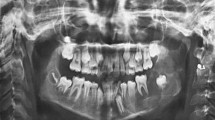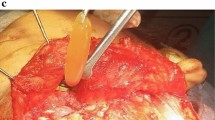Abstract
Purpose
The purpose of this study is to put forth our 15 year experience with pediatric ameloblastoma in the Indian population.
Materials and Method
This retrospective study was carried out in the pediatric group of 18 years and below, presenting with and diagnosed for ameloblastoma, at our institution over the past 15 years. The required data was collected by reviewing patient’s case notes, relevant radiographs, histopathological reports, and treatment charts. The incidence of pediatric ameloblastomas with respect to age, sex, site of occurrence, histopathologic type, the type of treatment instituted, and recurrence rate was noted.
Results
Of the total 165 pediatric tumors, ameloblastoma was the most common, 29 cases (17.5%). It occurred commonly in the age group of 12–18 years (mean age 14 years) with a marked male predilection. The most common site of occurrence was the posterior mandible. Majority were of the unicystic type. Two ameloblastomas which appeared as unilocular radiolucency were diagnosed as solid type. Twenty-eight were benign and one was a rare malignancy (Ameloblastic carcinosarcoma). Only two recurrences were noted over 15 years, of which one tumor interestingly recurred as a peripheral variety which responded well to local excision. Ameloblastomas were either enucleated with mechanical curettage or resected followed by primary reconstruction with either a reconstruction plate or free fibula flap.
Conclusion
We conclude that ameloblastomas are not uncommon in Indian pediatric population. Unilocular, unicystic ameloblastomas in the pediatric age group can be treated conservatively owing to their growth potential. Emphasis must be given to a long-term regular follow-up, conserving a more radical approach in case of a recurrence. However, Unilocular appearing ameloblastomas may be of the solid type which needs to be borne in mind as it not only alters the treatment modality but also emphasizes the importance of pre-operative incisional biopsy. Solid and unicystic aggressive ameloblastomas must be treated radically. Primary reconstruction with the free fibula flap is a viable option.

















Similar content being viewed by others
References
Olaitan AA, Adekeye EO (1996) Clinical features and management of ameloblastoma of the mandible in children and adolescents. Br J Oral Maxillofac Surg 34:248–251
Rapidis AD, Andressakis DD, Stavrianos SD, Faratzis G, Arnogiannaki-Liappi N, Lagogiannis GA et al (2004) Ameloblastomas of the jaws: clinicopathological review of 11 patients. Eur J Surg Oncol 30:998–1002
Keszler A, Dominguez FV (1986) Ameloblastoma in childhood. J Oral Maxillofac Surg 44:609–613
Ueno S, Nakamura S, Mushimoto K, Shirasu R (1986) A clinicopathologic study of ameloblastoma. J Oral Maxillofac Surg 44:361–365
DeLair D, Bejarano PA, Peleg M, El-Mofty SK (2007) Ameloblastic carcinosarcoma of the mandible arising in ameloblastic fibroma: a case report and review of the literature. Oral Surg Oral Med Oral Pathol Oral Radiol Endod 103(4):516–520
Ord RA, Blanchaert RH Jr, Nikitakis NG, Sauk JJ (2002) Ameloblastoma in children. J Oral Maxillofac Surg 60:762–770
Kahn MA (1989) Ameloblastoma in young persons: a clinicopathologic analysis and etiologic investigation. Oral Surg Oral Med Oral Pathol 67:706–715
Arotiba GT, Ladeinde AL, Arotiba JT, Ajike SO, Ugboko VI, Ajayi O (2005) Ameloblastoma in Nigerian children and adolescents: a review of 79 cases. J Oral Maxillofac Surg 63:747–751
Chidzonga MM (1996) Ameloblastoma in children. The Zimbabwean experience. Oral Surg Oral Med Oral Pathol Oral Radiol Endod 81:168–170
Huang IY, Lai ST, Chen CH, Chen CM, Wu CW, Shen YH (2007) Surgical management of ameloblastoma in children. Oral Surg Oral Med Oral Pathol Oral Radiol Endod 104:478–485
Takahashi IK, Miyauchi K, Sato K (1998) Treatment of ameloblastoma in children. Br J Oral Maxillofac Surg 36:453–456
Daramola JO, Ajagbe HA, Oluwasanmi JO (1975) Ameloblastoma of the jaws in Nigerian children: a review of sixteen cases. Oral Surg Oral Med Oral Pathol 40:458–463
Chuong R, Kaban LB (1985) Diagnosis and treatment of jaw tumors in children. J Oral Maxillofac Surg 43:323–332
Sato M, Tanaka N, Sato T, Amagasa T (1997) Oral and maxillofacial tumors in children: a review. Br J Oral Maxillofac Surg 1:26–31
Zhang Jing, Zexu GU, Jiang Lin, Zhao Jinlong, Tian Meiyu, Zhou Jun, Duan Yinzhong (2010) Ameloblastoma in children and adolescents. Br J Oral Maxillofac Surg 48:549–554
Arotiba GT (1996) A study of orofacial tumours in Nigerian children. J Oral Maxillofac Surg 54:34–38
Leider AS, Eversole LR, Barkin ME (1985) Cystic ameloblastoma: a clinicopathologic analysis. Oral Surg Oral Med Oral Pathol 60:624–630
Pogrel MA, Montes DM (2009) Is there a role for enucleation in the management of ameloblastoma? Int J Oral Maxillofac Surg 38:807–812
Rosenstein T, Pogrel MA, Smith RA, Regezi JA (2001) Cystic ameloblastoma—behaviour and treatment of 21 cases. J Oral Maxillofac Surg 59:1311–1316
Shinoda T et al (1992) Cytologic appearance of ameloblastic carcinosarcoma (malignant ameloblastoma and fibrosarcoma) of maxilla: a case report. Acta Cytol 36:132–136
Tanaka T, Ohkibo T, Fujitsuka H (1991) Malignant mixed tumour (malignant ameloblastoma and fibrosarcoma) of the maxilla. Arch Pathol Lab Med 115:84–87
Kunkal M, Ghalibafiam M, Radner H, Reichert TE, Fischer B, Wagner W (2004) Ameloblastic fibrosarcoma or odontogenic carcinosarcoma: a matter of classification? Oral Oncol 40:444–449
Slater LJ (1999) Odontogenic sarcoma and carcinosarcoma. Seminar Diag Pathol 16:325–332
Conflict of interest
The authors hereby wish to state that this paper does not have any financial and personal relationships with other people or organisations that could inappropriately influence (bias) their work.
Author information
Authors and Affiliations
Corresponding author
Rights and permissions
About this article
Cite this article
Andrade, N.N., Shetye, S.P. & Mhatre, T.S. Trends in Pediatric Ameloblastoma and its Management: A 15 year Indian Experience. J. Maxillofac. Oral Surg. 12, 60–67 (2013). https://doi.org/10.1007/s12663-012-0387-1
Received:
Accepted:
Published:
Issue Date:
DOI: https://doi.org/10.1007/s12663-012-0387-1




